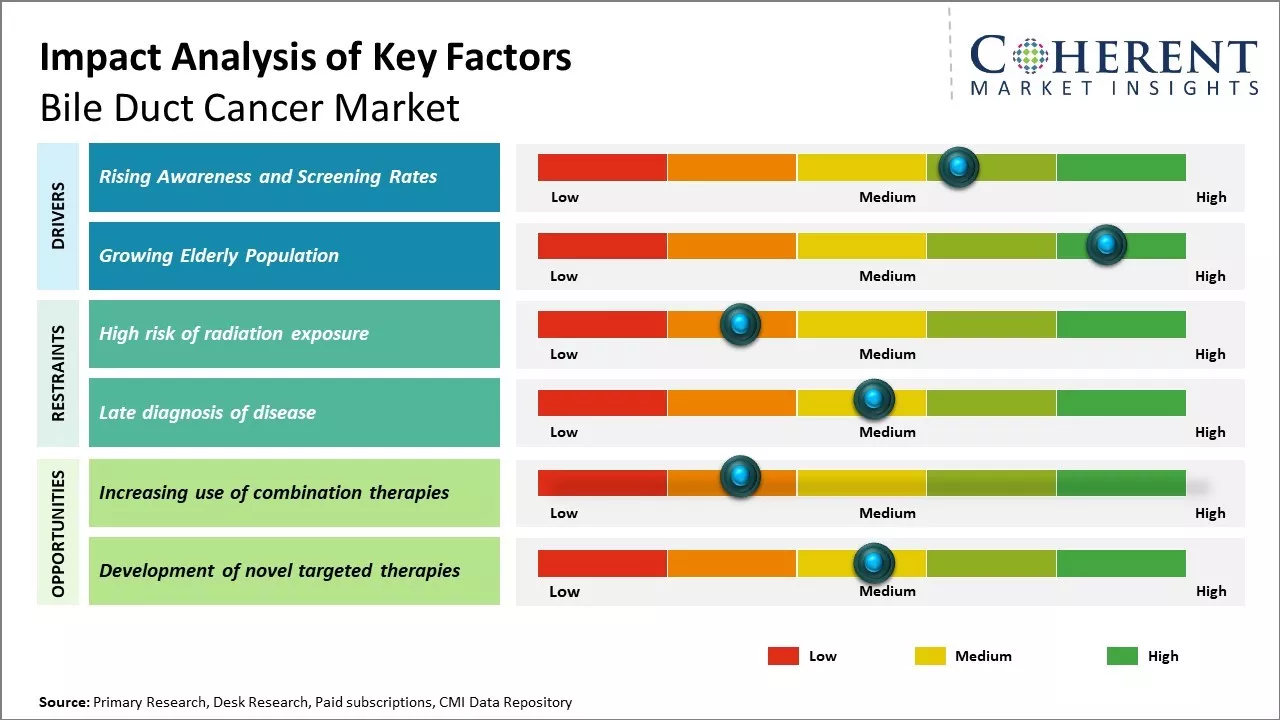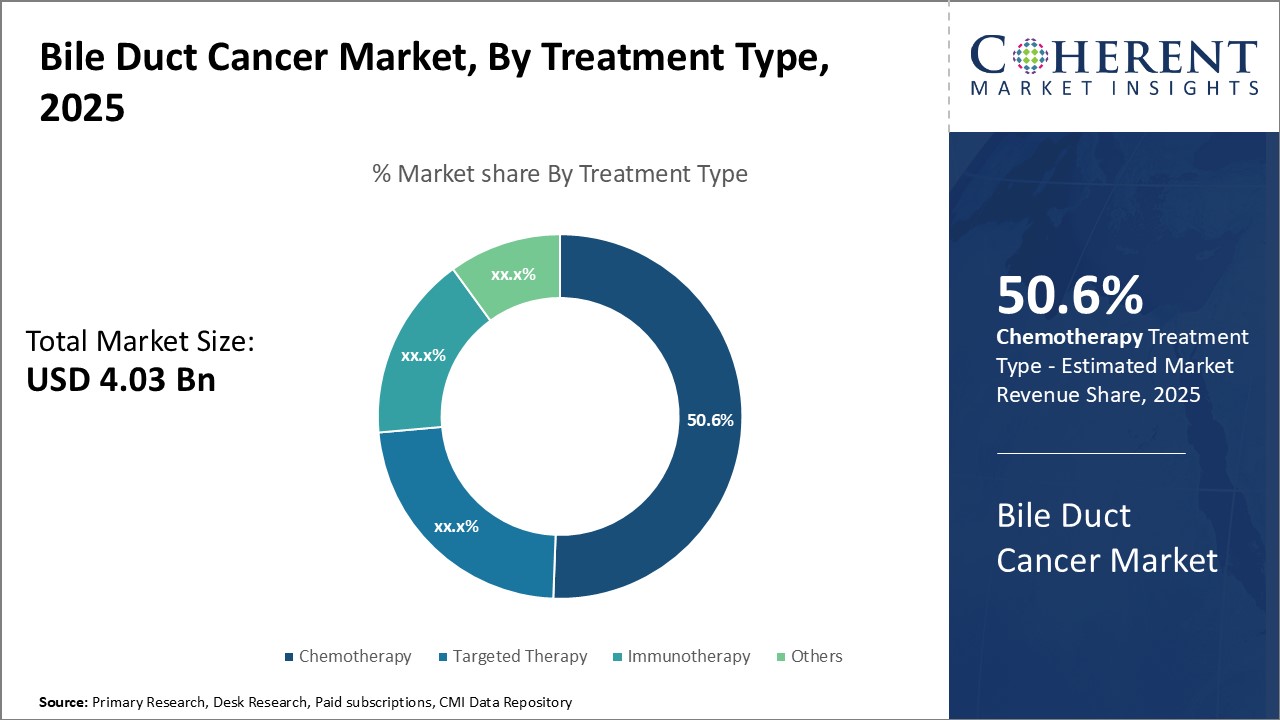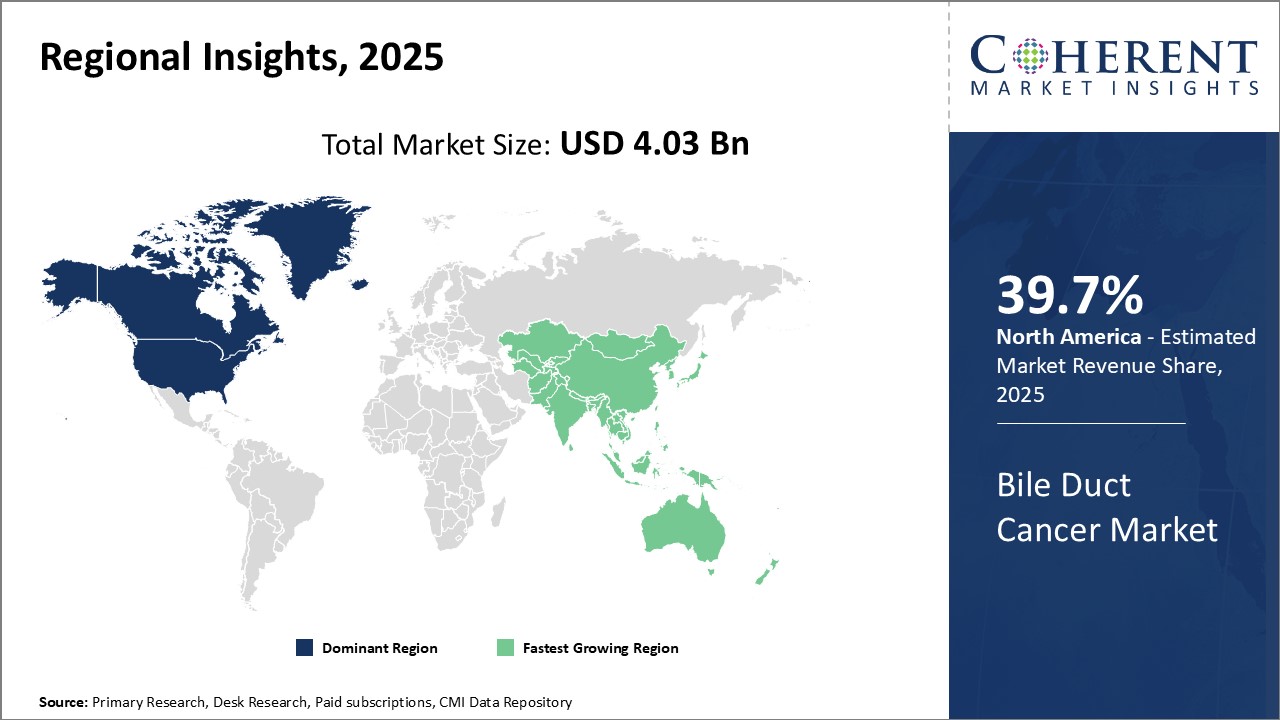Global bile duct cancer market is estimated to be valued at US$ 4.03 Bn in 2025 and is expected to reach US$ 7.18 Bn by 2032, exhibiting a compound annual growth rate (CAGR) of 8.6% from 2025 to 2032. Improved diagnosis and screening of this cancer can boost early detection, resulting in increased treatment rates. Furthermore, expanded insurance coverage for costly surgery and chemotherapy treatment can also drive the market growth.

Discover market dynamics shaping the industry: Download Free Sample
The market is witnessing positive trends due to development and approval of novel drugs for treatment. Targeted therapies and immunotherapies have shown promising results in clinical trials for advanced stages of bile duct cancer. Researchers are also exploring combinations of immunotherapy with chemotherapy or radiation therapy to boost treatment effectiveness. These developments are expected to boost adoption of high-priced specialty drugs in the near future.
Rising Awareness and Screening Rates
Increasing awareness about bile duct cancer, its causes, risk factors and ways to potentially catch the disease early can drive the market growth. More people now recognize the importance of regular screening, especially for those in high-risk groups based on age, family history or known medical conditions. Doctors have improved their understanding of the disease and learned to watch out for certain warning signs and symptoms that may point to bile duct cancer developing. Thus, screening rates have increased in the past decade in most countries. This has translated to many more cases now being detected at earlier stages when treatment options tend to be more effective. Detecting the disease early often means less invasive procedures needed, thus, boosting demand for services and therapies related to bile duct cancer. Heightened public education efforts by cancer societies and support organizations can boost screening rates and subsequent early detection in the near future. For instance, in January 2023, according to the data published by University College London, an international multicenter trial, including researchers from UCL and University College London Hospitals NHS Trust (UCLH), a novel personalized cancer therapy holds the potential to substantially enhance the prognosis for certain individuals diagnosed with bile duct cancer.

Get actionable strategies to beat competition: Download Free Sample
Growing Elderly Population
Growing elderly population worldwide can also drive the market growth. Bile duct cancer is predominantly a disease of older adults, with incidence rates sharply rising after age 70, demographic trends point towards a growing at-risk population base. Medical advancements have increased average lifespans of people globally. The expanding proportion of older persons especially in developed nations means that issues affecting the senior demographic, such as bile duct cancer, will correspondingly affect more individuals. Developing countries are witnessing their own aging transitions. This market driver underscores the necessity for continued progress in bile duct cancer treatments, diagnostic methods, and palliative care options to effectively serve the growing numbers of elderly patients worldwide who may develop this challenging form of cancer. Combined with better screening and early detection, the aging population can drive the market growth.
Key Takeaways from Analyst:
Global bile duct cancer market growth is driven by factors like rising elderly population who are more prone to bile duct cancer, increasing environmental risk factors like obesity and primary sclerosing cholangitis, growing awareness about early screening and diagnosis improving treatment rates.
However, factors like delayed diagnosis and limited treatment options can hamper the market growth. Since symptoms occur at later stages, most cases are diagnosed at an advanced stage limiting treatment effectiveness. Lack of targeted therapies and clinical trials also restrain the market growth.
North America dominates the bile duct cancer market during the forecast period owing to high healthcare spending, availability of advanced diagnostic technologies, favorable reimbursement policies, and growing clinical trials for newer treatment approaches in the region. Meanwhile, Asia Pacific is expected to witness the fastest growth in this market due to rising healthcare investments, increasing disposable incomes, growing awareness about early detection in countries like China and India.
Market Challenges: Late diagnosis
Late diagnosis of bile duct cancer can hamper the growth of the global bile duct cancer market. Bile duct cancer, also known as cholangiocarcinoma, is a rare but lethal form of cancer that develops in the bile ducts. The bile ducts are thin tubes that connect the liver, gallbladder and small intestine and carry the digestive fluid called bile. Bile duct cancer does not usually cause any signs or symptoms in the early stages. By the time someone develops jaundice, weight loss or abdominal pain, the cancer is usually in an advanced stage. This makes diagnosis difficult as advanced cancer would have already spread by the time it is detected.
Market Opportunities: Favorable government initiatives or government support
The use of combination therapies, where two or more treatments are used together, is emerging as an important opportunity for bile duct cancer treatment. Combination regimens allow oncologists to target the cancer from multiple angles, attacking different pathways and processes that drive tumor growth and progression. This dual or multi-pronged approach can help overcome resistance and be more effective than single-agent treatments. Some promising combination strategies currently being explored include chemotherapy combined with radiation therapy or immunotherapy. Clinical trials show evidence that combining chemotherapy like gemcitabine with radiation therapy prior to surgery may improve resection rates and long-term outcomes for individuals with bile duct cancer.

Discover high revenue pocket segments and roadmap to it: Download Free Sample
In terms of Treatment Type, Chemotherapy segment contributes the highest share of the market owing to its wide acceptance and efficacy
By treatment type, chemotherapy segment is estimated to contribute the highest market share of 50.6% in 2025, owing to its proven efficacy as well as widespread acceptance among medical practitioners. Chemotherapy has been the mainstay treatment option for bile duct cancer for several years now.. Chemotherapy works by slowing or stopping the growth of cancer cells that grow and divide quickly. Since bile duct cancer is a rapidly progressive disease, chemotherapy is able to target these quickly dividing cancer cells and delay their progression. Several chemotherapy drugs have been approved and used extensively for treating bile duct cancer in the curative, neoadjuvant and palliative settings. These include drugs like gemcitabine, cisplatin, capecitabine, and others. Clinical trials have time and again demonstrated reasonable response rates and improved survival benefits when chemotherapy is used for treating advanced or unresectable bile duct cancer. With increasing research, newer chemotherapy regimens and combinations are being evaluated which are improving treatment outcomes further.
In terms of Distribution Channel, Hospital Pharmacies segment contributes the highest share of the bile duct cancer treatment market owing to centralized procurement and ready availability
By distribution channel, hospital pharmacies segment is estimated to contribute the highest market share of 50.23 % in 2025. This is because a majority of bile duct cancer patients receive complex treatment regimens involving intravenous chemotherapy along with supportive medications. Hospitalization have became necessary for administering these intensive therapies through which medicines can be conveniently procured from hospital pharmacies. Most bile duct cancer patients undergo surgery, followed by adjuvant chemotherapy to reduce the risk of recurrence. This entire treatment process from surgery to follow up chemotherapy often takes place during admitted stays at hospitals itself. It becomes convenient for patients to obtain their prescribed drugs from the pharmacy services available right within the hospital premises. Furthermore, hospital pharmacies allow for centralized procurement of expensive cancer drugs by hospitals directly from manufacturers. This centralized procurement results in bulk discounts and cost savings, which benefits both patients and healthcare facilities. Hospital pharmacies also ensure seamless availability of all drugs required as part of complex treatment regimens. This avoids stock outs and improves conformity to treatment schedules.

Need a Different Region or Segment? Download Free Sample
North America dominates the global bile duct cancer market owing to well-established healthcare infrastructure and high adoption of advanced technologies with estimated market share of 39.7% in 2025. The U.S. alone contributes over 50.5% of market share due to significant healthcare expenditure and presence of leading industry players. Several new product launches catering to early diagnosis and effective treatment have further strengthened market position. The favorable reimbursement policies increase affordability of innovative therapies in the region. With growing geriatric population more susceptible to cancer, industry experts anticipate demand to rise steadily over the coming years.
Asia Pacific is the fastest growing regional market. Rapid economic development across China, India and Southeast Asian countries has boosted healthcare infrastructure and expanded access to quality care. Coupled with rising healthcare expenditure, more focus is being placed on research-oriented activities to facilitate domestic production. China especially is working towards achieving self-sufficiency in manufacturing advanced medical technologies through joint ventures and acquisitions. The lack of stringent regulations as compared to developed regions further encourages regional as well as global players to test novel products. While import duties remain higher, successful localization initiatives are gradually decreasing dependency on imports. With its massive patient pool and growing medical tourism, Asia Pacific is likely to play a key role in shaping the future bile duct cancer market landscape.
Bile Duct Cancer Market Report Coverage
| Report Coverage | Details | ||
|---|---|---|---|
| Base Year: | 2024 | Market Size in 2025: | USD 4.03 Bn |
| Historical Data for: | 2020 To 2024 | Forecast Period: | 2025 To 2032 |
| Forecast Period 2025 to 2032 CAGR: | 8.6% | 2032 Value Projection: | USD 7.18 Bn |
| Geographies covered: |
|
||
| Segments covered: |
|
||
| Companies covered: |
F. Hoffmann-La Roche Ltd, Sanofi, Pfizer Inc., Bristol-Myers Squibb Company, Eli Lilly and Company, Merck & Co., Inc., Novartis AG, Celgene Corporation, Johnson & Johnson Services, Inc., Teva Pharmaceutical Industries Ltd., Bayer AG, Fresenius Kabi AG, Mylan N.V., ConMed Corporation, Boston Scientific Corporation, Taiho Pharmaceutical Co., Ltd., Incyte Corporation |
||
| Growth Drivers: |
|
||
| Restraints & Challenges: |
|
||
Uncover macros and micros vetted on 75+ parameters: Get instant access to report
*Definition: Global Bile Duct Cancer Market involves the development and commercialization of various therapeutic products such as drugs, devices, and treatments that are specifically targeted for bile duct cancer. The different products under this market include drugs for chemotherapy as well as immuno-oncology, radiotherapy systems, stenting and drainage devices, and robotic surgical systems that help treat bile duct cancer at different stages in a minimally invasive manner.
Share
Share
About Author
Vipul Patil is a dynamic management consultant with 6 years of dedicated experience in the pharmaceutical industry. Known for his analytical acumen and strategic insight, Vipul has successfully partnered with pharmaceutical companies to enhance operational efficiency, cross broader expansion, and navigate the complexities of distribution in markets with high revenue potential.
Missing comfort of reading report in your local language? Find your preferred language :
Transform your Strategy with Exclusive Trending Reports :
Frequently Asked Questions
Joining thousands of companies around the world committed to making the Excellent Business Solutions.
View All Our Clients